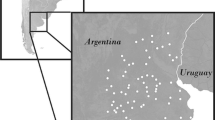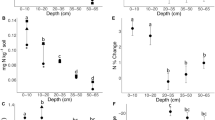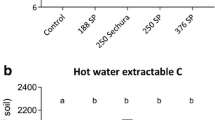Abstract
There are few records of long-term trends in soil C and N in grazed pasture systems but recent measurements have demonstrated unexplained losses on New Zealand lowlands. To determine whether losses were also occurring in hill country pastures, we analyzed archived soil samples collected between 1983 and 2006 from two slope classes (steep and easy) at the Whatawhata Research Centre. Soils were Ultic Hapludand and Typic Haplohumult on the easy slopes (10–20°), and Typic Haplohumult on the steeper slopes (30–40°). Soil samples (0–75 mm) had been collected from paddocks that were fertilized with six different loading rates of P (ranging from 0 to 100 kg P ha−1 year−1 since 1985). This range of P loadings allowed us to determine whether P inputs would regulate trends in soil C and N. While there were significant temporal trends in C and N (P < 0.05), these were not unidirectional and trends were not dependent on P loading rate. On average, soil C initially increased during the first 6 years of the trial at 0.270% C year−1 (1.56 t ha−1 year−1) and 0.156% C year−1 (1.06 t ha−1 year−1) on easy and steep slopes, respectively. Subsequently, there was no significant trend in soil C on the easy slopes but soil C declined at −0.066% year−1 (0.45 t ha−1 year−1) on the steep slopes. Similarly, soil N increased between 1983 and 1989 at 0.025% N year−1 (144 kg ha−1 year−1) and 0.012% N year−1 (82 kg ha−1 year−1) on easy and steep slopes, respectively. Post-1989, small but significant losses of total N were measured on the steep slopes of 0.004% year−1 (27 kg N ha−1 year−1) (P < 0.05) with no trend on the easy slopes. Two potential causal factors for these decadal-scale patterns were identified, operating via changes in primary productivity. These were lower S inputs from 1989 due to a change in fertilizer type, and a series of relatively dry summers during the 1990s. These significant inter-annual trends in soil C and N complicate attempts to measure long-term changes in soil organic matter associated with land use change and management practices. This study has demonstrated the potential error associated with infrequent soil sampling to determine long-term trends in soil C and N; large gains or losses could have been detected at Whatawhata depending on when sampling started and finished. Understanding these long-term trends in soil organic matter dynamics and driving factors requires more long-term sampling trials.



Similar content being viewed by others
Abbreviations
- SU:
-
Stocking units
References
Aires LMI, Pio CA, Pereira JS (2008) Carbon dioxide exchange above a Mediterranean C3/C4 grassland during two climatologically contrasting years. Glob Change Biol 14:539–555
Allard V, Soussanna J-F, Falcimagne R, Berbigier P, Bonnefond JM, Ceschia E, D’hour P, Henault C, Laville P, Pinares-Patino C (2007) The role of grazing management for the net biome productivity and greenhouse gas budget (CO2, N2O and CH4) of a semi-natural grassland. Agric Ecosyst Environ 121:47–58
Baldocchi D (2008) ‘Breathing’ of the terrestrial biosphere: lessons learnt from a global network of carbon dioxide flux measurement systems. Aust J Bot 56:1–26
Batjes NH (1996) Total carbon and nitrogen in soils of the world. Eur J Soil Sci 47:151–163
Bellamy PH, Loveland PJ, Bradley RI, Lark RM, Kirk GJD (2005) Carbon losses from all soils across England and Wales. Nature 437:245–248
Chou WW, Silver WL, Jackson RD, Thompson AW, Allen-Diaz B (2008) The sensitivity of annual grassland carbon cycling to the quantity and timing of rainfall. Glob Change Biol 6:1382–1394
Conant RT, Paustian K, Del Gosso SJ, Parton WJ (2005) Nitrogen pools and fluxes in grassland soils sequestering carbon. Nutr Cycl Agroecosyst 71:239–248
Cornforth IS, Sinclair A (1984) Fertiliser and lime recommendations for pasture and crops in New Zealand, 2nd revised edn. New Zealand Ministry of Agriculture and Fisheries, Wellington
Cuttle SP, Scurlock RV, Davies BMS (1998) A 6-year comparison of nitrate leaching from grass/clover and N-fertilised grass pastures grazed by sheep. J Agric Sci 131:39–50
Dodd MB, Ledgard SF (1999) Long term effects of withholding superphosphate application on North Island hill country; a 10 year update. Proc NZ Grassl Assoc 61:63–68
Dodd MB, Sheath GW, Wedderburn ME, Tarbotton IS (2001) Long-term performance of white clover cultivars oversown into a summer-dry hill country. Proc NZ Grassl Assoc 63:85–89
Edmeades DC, Thorrold BS, Roberts AHC (2005) The diagnosis and correction of sulphur deficiency and the management of sulphur requirements in New Zealand pastures: a review. Aust J Exp Agric 45:1205–1223
Gillingham AG, Richardson S, Power IL, Riley J (1990) Long-term effects of withholding phosphate application on North Island hill country, Whatawhata Research Centre. Proc NZ Grassl Assoc 51:11–16
Gillingham AG, Sheath GW, Gray MH, Webby RW (2003) Management and nitrogen fertiliser options for increased pasture productivity in dryland hill systems. In: Moot DJ (ed) Legumes for dryland pastures. Grassland Research and Practice Series No. 11. New Zealand Grassland Association, Wellington, pp 43–50
Hewitt AE (1998) New Zealand soil classification. Manaaki Whenua Press, Landcare Research, Lincoln
Jackman RH (1964) Accumulation of organic matter in some New Zealand soils under permanent pasture. I. Patterns of change of organic carbon, nitrogen, sulphur and phosphorus. NZ J Agric Res 7:445–471
Johnson IR, Chapman DF, Snow VO, Eckard RJ, Parsons AJ, Lambert MG, Cullen BR (2008) DairyMod and EcoMod: biophysical pasture simulation models for Australia and New Zealand. Aust J Exp Agric 48:621–631
Lal R (2003) Global potential of soil carbon sequestration to mitigate the greenhouse effect. Crit Rev Plant Sci 22:151–184
Lambert MG (1987) Nitrogen fixation during improvement of North Island hill country pastures. NZ J Agric Res 15:267–270
Lambert MG, Clark DA, Mackay AD, Costall DA (2000) Effects of fertiliser application on nutrient status and organic matter content of hill soils. NZ J Agric Res 43:127–138
Ledgard SF (2001) Nitrogen cycling in low input legume-based agriculture, with emphasis on legume/grass pastures. Plant Soil 228:43–59
Ledgard SF, Brier GJ, Littler RA (1987) Legume production and nitrogen fixation in hill pasture communities. NZ J Agric Res 30:413–421
MacLeod CJ, Moller H (2006) Intensification and diversification of New Zealand agriculture since 1960: an evaluation of current indicators of land use change. Agric Ecosyst Environ 115:201–218
Manderson A, Palmer A (2006) Soil information for agricultural decision making: a New Zealand perspective. Soil Use Manag 22:393–400
Metherell AK (2003) Management effects on soil carbon storage in New Zealand Pastures. Proc NZ Grassl Assoc 65:259–264
Moir JL, Scotter DR, Hedley MJ, MacKay AD (2000) A climate-driven, soil fertility dependent, pasture production model. NZ J Agric Res 43:491–500
Morton JD, Roberts AHC (1999) Fertiliser use on New Zealand sheep and beef farms. New Zealand Fertiliser Manufacturers’ Research Association, Auckland
Myers TP (2001) A comparison of summertime water and CO2 fluxes over rangeland for well watered and drought conditions. Agric For Meteorol 106:205–214
Nguyen ML, Goh KM (1990) Accumulation of soil sulphur fractions in grazed pastures receiving long-term superphosphate applications. NZ J Agric Res 33:111–128
Parliamentary Commissioner for the Environment (2004) Growing for good. Intensive farming, sustainability and the New Zealand environment. Parliamentary Commissioner for the Environment, Wellington, 236p
Pinheiro JC, Bates DM, DebRoy S, Sarkar D, The R Core team (2008) Nlme: linear and nonlinear mixed effects models. R Package Version 3:1–88
Rowarth JS, Gillingham AG (1990) Effects of withholding fertiliser on pasture production and phosphate cycling in hill country. Proc NZ Grassl Assoc 51:17–20
Saggar S, Mackay AD, Hedley CB (1999) Hillslope effects on the vertical fluxes of photosynthetically fixed 14C in a grazed pasture. Aust J Soil Res 37:655–666
Schipper LA, Percival HJ, Sparling GP (2004) An approach for estimating maximum nitrogen storage in soils. Soil Use Manag 20:281–286
Schipper LA, Baisden WT, Parfitt RL, Ross C, Claydon JJ, Arnold G (2007) Large losses of soil C and N from soil profiles under pasture in New Zealand during the past 20 years. Glob Change Biol 13:1138–1144
Soil Survey Staff (2006) Keys to soil taxonomy, 10th edn. US Department of Agriculture-NRCS, Washington
Sparling GP, Schipper LA (2002) Soil quality at a national scale in New Zealand. J Environ Qual 31:1848–1858
Sparling GP, Schipper LA (2004) Soil quality monitoring in New Zealand: trends and issues arising from a broad-scale survey 1995–2001. Agric Eco Environ 104:545–552
Steinfeld H, Gerber P, Wassenaar T, Castel V, Rosales M, de Haan C (2006) Livestock’s long shadow. FAO, Rome
Tait A, Woods R (2007) Spatial interpolation of daily potential evapotranspiration for New Zealand using a spline model. J Hydrometeorol 8:430–438
Tate KR, Giltrap DJ, Claydon JJ, Newsome PF, Atkinson IAE, Taylor MD, Lee R (1997) Organic carbon stocks in New Zealand’s terrestrial ecosystems. J R Soc N Z 27:315–335
Williams PH, Haynes RJ (1990) Influence of improved pastures and grazing animals on nutrient cycling within New Zealand soils. NZ J Ecol 14:49–57
Acknowledgments
This work was funded by Landcare Research through contract C09X0705 with the Foundation of Research, Science and Technology (FRST) and the University of Waikato and by AgResearch through a sub-contract of the FRST SLURI programme. Bridget Wise and Marie Heaphy are thanked for facilitating access to the soil sample archives and soil processing. Graham Sparling, Roger Parfitt, anonymous reviewers and Troy Baisden (Associate Editor Biogeochemistry) are thanked for critical comments and suggestions.
Author information
Authors and Affiliations
Corresponding author
Rights and permissions
About this article
Cite this article
Schipper, L.A., Dodd, M.B., Fisk, L.M. et al. Trends in soil carbon and nutrients of hill-country pastures receiving different phosphorus fertilizer loadings for 20 years. Biogeochemistry 104, 35–48 (2011). https://doi.org/10.1007/s10533-009-9353-5
Received:
Accepted:
Published:
Issue Date:
DOI: https://doi.org/10.1007/s10533-009-9353-5




